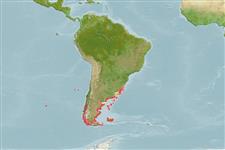Common names from other countries
Classification / Names / Names
Namen | Synonyme | Catalog of Fishes (gen., sp.) | ITIS | CoL | WoRMS
Environment: milieu / climate zone / depth range / distribution range
Ökologie
. Temperate; 32°S - 55°S, 74°E - 52°E (Ref. 83435)
Southeast Pacific, Southwest Atlantic and Antarctic Indian Ocean.
Length at first maturity / Size / Gewicht / Alter
Maturity: Lm ? range ? - ? cm Max length : 2.4 cm DL Männchen/unbestimmt; (Ref. 83435); max. veröff. Alter: 5 Jahre (Ref. 8702)
It is found in intertidal areas of rocky coasts in rock crevices, artificial substrates, on barnacles or mussels (Ref. 87801). It is also found in forests of Macrocystis pyrifera (Ref. 92889).
Life cycle and mating behavior
Geschlechtsreife | Fortpflanzung | Ablaichen | Eier | Fecundity | Larven
Egg masses are composed of numerous ovate egg capsules each containing a single embryo that develops within and emerges as a veliger larva. Indirect development.
Rosenberg, G. 2009. (Ref. 83435)
IUCN Rote Liste Status (Ref. 130435)
CITES Status (Ref. 108899)
Not Evaluated
Not Evaluated
Nutzung durch Menschen
| FishSource |
Tools
Internet Quellen
Estimates based on models
Preferred temperature
(Ref.
115969): 7.1 - 14.2, mean 9.5 (based on 269 cells).
Preiskategorie
Unknown.
